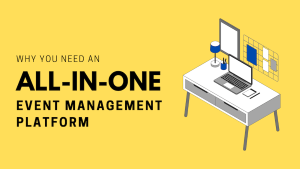
What do you think is the one thing that your conference attendees wouldn’t appreciate? If your answer is long queues outside the event venue, then you’re probably still stuck with traditional ways of event check-ins. As with all aspects of organizing an event, the check-in process has also evolved. Organizers today don’t shy away from exploring various digital tools for a smoother attendee check-in process at events.
However, if you need clarity on creating strategies for a fuss-free event check-ins, you’re at the right place. Stick around as we explore different strategies and help you make your attendee check-in process seamless.
Strategies For Academic Event Check-ins
Having a solid event check-in strategy is essential regardless of the size of your academic event. Hence, we have compiled some of the best strategies for your inspiration.
Set the Ball Rolling With a Solid Entry Plan
Come up with a simple yet efficient plan for attendee check-ins at your academic event. This allows you to check which attendees are participating in which sessions. You also get a better understanding of how many staff you need to deploy for the different sessions. Know your layout before beginning with your event access management plan.
Additionally, think about the timing of your event. If your academic conference starts at 11 AM, don’t wait till 10:50 to open the gates. Allow people to settle in before the sessions begin. This helps reduce stress for both attendees and staff.
A well-defined entry plan ends last-minute chaos and ensures the process stays seamless during peak arrival times.
Send Out Pre-event Emails With Steps to Check-in
Make sure to provide important venue information to event attendees days ahead of the event. It’s common for many organizers to put check-in details in other event communications. Don’t fall into this trap! Send out a separate email, particularly to help attendees understand the check-in process.
Maintaining email communications about check-ins helps manage attendee expectations.
Opt for Contactless Event Check-ins
Contactless check-ins offer safety, speed and a better experience all at once. It helps cut down the waiting time as conference attendees check in with their phones. Attendees can quickly scan the QR code and walk in. Or you can also send the QR code to them right before the event. Your staff scans it at the gate and lets them in. No delays, no confusion.
Many modern university conferences are switching to contactless event check-ins. Attendees appreciate the convenience, which means your event starts off on a positive note.
Educate Your Staff on Session Check-ins
Your event management team needs to know how to use the tools way before your event is set in motion. Make sure you devote significant time to training the event volunteers and staff on how the check-in process works. Teach them what to do if an attendee’s name doesn’t show up. Hence, these training sessions prepare the staff for unusual situations such as lost tickets or duplicate entries.
Tell the staff to stay calm throughout the entire check-in process. The participants may be confused, tired or in a rush. A friendly face at the gate can bring a huge difference to the participants’ conference experience.
Put Up Clear Signages Across the Event Venue
Attendees can get confused with the directions at the event venue. This may slow down the entry. This is why using appropriate signage in an academic event is necessary. Consider the following aspects when putting up signage:
-
- Make sure they are at eye level
- Use big fonts
- Keep the message short
For example, instead of saying “Welcome to Our Academic Conference”, the message should be “Quick Check-in This Way.” The placement of signage ensures the attendees are going in the right direction and relieves the burden on the staff. This particularly helps first-time attendees as they navigate through the event.
Maintain Separate Queues Based on Ticket Type
When hosting an academic conference, you may have different types of attendees. Some are speakers, some are researchers and some are students. It’s best if you don’t mix them all up; instead, ask them to enter through separate queues. This way, speakers don’t miss their slots and VIPs get in faster. Even regular attendees don’t feel ignored. It’s a win-win for everyone.
If you plan to use QR codes for your events, you can assign color codes to them. This helps your event team categorize the attendees more effectively. Dividing the lines enhances efficiency by minimizing bottlenecks. It makes the check-in process more personalized for different groups of attendees.
Use an Event Check-in App
It’s a lot more convenient to have a mobile app for event check-ins than using paper lists. Apps make the check-in process faster. All you need to do is search the name, tap and it’s done. You can incorporate the QR scanner feature on your mobile event app, which makes the process even quicker. Moreover, you can sync the app with your registration system. This way, if someone registered online, their name is already in the event database. Hence, it’s error-free and time-efficient.
Employ On-Demand Badge Printing Features
All you need is a simple software and a remote printer connection to print the badges. This saves space at your registration tables and you won’t have to hold up lines trying to spot a particular person’s badge.
On-demand badge printing becomes more convenient when you use a CRM-integrated app. These CRM systems already come with synced attendee data, which means you have all the information you need to generate the badges.
Remind Attendees Before the Event
A day before the event, send a message and email with the check-in details. Here are a few things to include in your message:
-
- The QR code
- The entry time
- Which gate to enter from
If you’re using a mobile app, send push notifications. This is even faster than email. These reminder messages reduce confusion and help attendees prepare. When attendees know what to expect, the check-in process becomes smoother.
Check Entry in Real-time
Keep a close watch on the entry. Use the event check-in app to check how many people have arrived. If the entry is slow, send more staff there. Open another counter if a line is getting long. Real-time monitoring helps you adapt quickly. It removes guesswork; you see the numbers and you act. This is the sign of smart event management.
If an attendee complains about waiting, you can check the data to verify whether they came early. Maybe they were in the wrong queue. Having the facts in front of you helps you respond better.
Collect Feedback after the Events
Event check-in doesn’t end at the gate. It only ends when the attendees are satisfied with the process. So seek feedback on how they felt about the check-in process. Here are a few you can ask them about:
-
- Ask if the entry was fast
- Ask if they liked the mobile check-in app
- Ask if the staff was helpful
When the guests notice that you care, they are more likely to return. Gathering valuable feedback also helps monitor long-term improvements.
Parting Thoughts
Traditional event check-in processes are not enough to satisfy the attendees. Find a balance between traditional and new-age strategies to maintain an excellent attendee experience. The future of event check-ins lies in utilizing contactless, data-sriven systems. This helps prioritize safety, speed and personalization.
Dryfta is the leading event management solution for offering innovative features such as self-service dashboards and real-time data sync. This makes sure of an unforgettable check-in experience for the attendees. Ask for a live demo to see how Dryfta simplifies the event check-in process.




